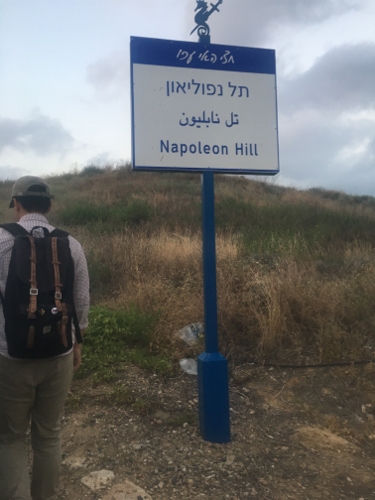Two Sides to Every Story
By Abigail Michael.
In coming to Tel Akko, there wasn’t much I expected to take me by surprise. Despite it being my first archaeological dig, I’ve done preliminary excavations back home in the States and I have been out of the country a few times before. If you had asked me about it beforehand, I could have replied with the old, “it’s not my first rodeo” line. And really, it isn’t. It’s a lot of work to be sure (if anything, perhaps I am more tired that I had expected, often going to bed around 8:30 to be sure I get eight hours of sleep, which is a shame when I might want to explore Akko), but not harder than I expected. It’s hot, but bearable with water and the shade provided by our lovely tarps: I haven’t even been sunburnt. I was blown away by the ancient sites we’ve visited so far, but, then, I expected to be. So, what is it that took me by surprise?
Napoleon.
Yes. That Napoleon. Perhaps you know about him and his “connection” to Tel Akko from reading other posts on this website or from following the dig’s Facebook page. I myself heard a bit about him before I arrived, but I did not quite realize the extent of his influence. If this is your first time hearing about him in connection with the excavations (or even if it’s your first time hearing about the excavations), then allow me to explain. Napoleon did indeed come to our fair Akko in 1799 to lay siege to the city. He lasted two months before he was defeated by al-Jazzar with help from the British. Taking into account the amount of times Napoleon was defeated on his campaigns, this is something that one would not be surprised to learn the citizens of Akko are proud of. And they are. But, the issue, in my opinion, is Tel Akko.
Only a few short years ago, as I am told by returning excavation members, a statue of our friend Napoleon was put up at Tel Akko. Why, you ask? It seems one day someone working for the city decided to put it up. Why? That one’s hard to answer. While Napoleon did come to Akko itself, that was long after the days of occupation on our tel. And though he besieged the city from a hill, that hill was not Tel Akko. Yet, despite these very logical facts, that’s where he sits. Or, rather, rides – the emperor is gallantly positioned astride his horse, proudly waving an Israeli flag. Yes. Even though he attacked the city (there is a reason for the flag, but it just amuses me to think of without going any further). In sum, the site has absolutely nothing to do with Napoleon. It’d be somewhat akin to placing a statue of George III waving an American flag in Roanoke.
When a resident of Akko asks us what we are doing while visiting their home, if we tell them about Tel Akko, they don’t always know where we mean. Then, if we say Tel Napoleon¸ they know what we’re talking about. Again, per seasoned expedition members, this statue was put up only a few years ago. Yet, he is now what the people of Akko think of when they think of that hill, and signs giving credence to Tel Napoleon or Napoleon Hill are all over the place.
Though it might be a shame that the people don’t know the true history of the site, there’s nothing to be done besides either being annoyed or amused by the whole situation of Napoleon being foisted on the tel. I choose amused. Still, it is an interesting case study. A narrative, albeit an untrue one, was widely and effectively spread throughout a city – and this with only one thin metal statue! It gives one studying archaeology, conservation, and public archaeology during their time in Akko something to think about. Museum staff, history teachers, and even municipal workers have the power to shape the public’s perspective on given events – for better or worse. Based on this example, it seems that it is not even difficult when one chooses the right method of getting their chosen narrative across. So, it is important for all of us students here at Tel Akko – as future conservators, archaeologists, curators, or whatever we chose to pursue within this field – to think carefully about this fact and choose the narratives we may present and how we present them carefully. Even something as simple as a statue without informative plaques of any sort around it can dictate the impression of a place on an entire city. If we take creative steps to present accurate narratives about history – perhaps something more interesting than the blue markers my hometown is so fond of (though those are great and I will not discount them) – we can have similar effects on those we tell our side of the story to.
